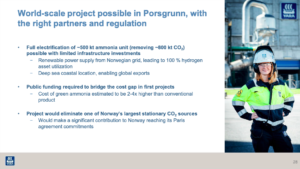Full electrification: Yara plans 500,000 tons of green ammonia in Norway by 2026
By Trevor Brown on December 10, 2020
Green ammonia projects continue to be announced at dizzying speed and scale. A few weeks ago, Origin Energy disclosed its feasibility study to develop 500 MW (hydro) / 420,000 tons per year of green ammonia in Tasmania, with first production targeted for mid-2020s.
This week, a consortium led by Haldor Topsoe and Vestas announced 10 MW (wind+solar) / 5,000 tons of green ammonia in Denmark, which could be operational in 2022, which would make it the first green ammonia plant at this scale.
Also this week, Yara made a significant corporate announcement, detailing a “transformation of its commercial business models, sales channels and offerings,” with the full decarbonization of its Porsgrunn plant at the heart of its strategy to use green ammonia “to enable the hydrogen economy.”
I’ve previously written about Yara’s collaboration with Nel Hydrogen on a 5 MW electrolyzer pilot at Porsgrunn. Already, this project has grown to 25 MW, with commercial start-up scheduled for early 2023.
Even so, this latest announcement is a massive expansion, roughly 100 times larger than the original project. And if the 5 MW pilot was designed to deliver cost reductions on the electrolyzers, imagine the impact that this larger scale deployment will have on electrolyzer costs this decade.

Full-scale electrification is also the logical next step in the company’s low-carbon ammonia journey, which so far includes introducing byproduct hydrogen feedstock at its Freeport (Texas, USA) and Sluiskil (Netherlands) plants; pilot projects and feasibility studies for full-scale green ammonia plants at Pilbara (Australia); and, most recently, a 100 MW (offshore wind) electrolyzer at Sluiskil to be operational in 2025, in collaboration with Ørsted.
All this has happened since 2018.
Building on its long experience and leading position within global ammonia production, logistics and trade, Yara aims to capture opportunities within shipping, agriculture and industrial applications, in a market expected to grow by 60 percent over the next two decades. Against this backdrop, Yara announces plans to fully electrify its ammonia plant in Porsgrunn, Norway with the potential to cut 800,000 tonnes of CO2 per annum, equivalent to the emissions from 300,000 passenger cars.
To make its vision of zero-emission ammonia production in Norway a reality, Yara is seeking partners and government support. If the required public co-funding and regulatory framework is in place, the project could be operational in 2026. The project would eliminate one of Norway’s largest static CO2 sources, and would be a major contributor for Norway to reach its Paris agreement commitments. Yara aims to fully remove CO2 emissions from its Porsgrunn ammonia production and thereby produce emission-free fuel for shipping, carbon-free fertilizer and ammonia for industrial applications.
Yara announcement, Yara ready to enable the hydrogen economy with historic full-scale green ammonia project, December 7, 2020

Of course, in Porsgrunn — like in Tasmania — a green ammonia producer has a tremendous advantage: an electricity grid almost entirely powered by hydro. This baseload power, not variable like wind and solar, increases the capacity utilization of hydrogen and ammonia production units, decreasing the product cost.
Beyond the information about the Porsgrunn plant, there were three aspects of this latest announcement that struck me as significant.
First, Yara’s announcement makes crystal clear that this project relies on government support (“public co-funding and regulatory framework”). This is perhaps a statement of the obvious but it is also a clear signal to policy-makers that Yara is ready and willing to decarbonize (and perhaps other ammonia producers as well), but cannot do so in a vacuum.
Second, Yara’s accompanying 90 minute, 40-page ESG investor presentation presents a detailed case for decarbonization as a sustainable business decision, a prudent investment with economic reward. The extent of the financial analysis supporting this project, and the senior executives delivering these messages, make it quite clear that the electrification of Porsgrunn is not a standalone project but a turning point on a corporate journey.
Third, Yara is not decarbonizing by itself — on the same day, it also announced a “Sectoral Decarbonization Approach,” with partners Nutrien and the World Business Council for Sustainable Development (WBCSD), and invited broader industry participation.
Global crop nutrition leaders Nutrien and Yara, along with the World Business Council for Sustainable Development (WBCSD), are undertaking a Sectoral Decarbonization Approach (SDA) for the Nitrogen fertilizer sector …
An SDA enables fertilizer companies to set GHG emission reduction targets which are aligned with the goals in the Paris agreement …
Based on the SDA process, Yara has submitted a commitment to set a Science Based Target to the Science Based Targets Initiative … The analysis required for determining a Sectoral Decarbonization Approach is expected to be finalized in 2022.
Although initiated by the two largest companies in the industry, Yara and Nutrien will alongside WBCSD invite other companies in the sector to join the project, creating a more coherent, scientific and ambitious approach to reducing the emissions from the fertilizer industry.
Yara announcement, Yara to Align Emission Reduction Goals with Paris Agreement Targets, December 7, 2020